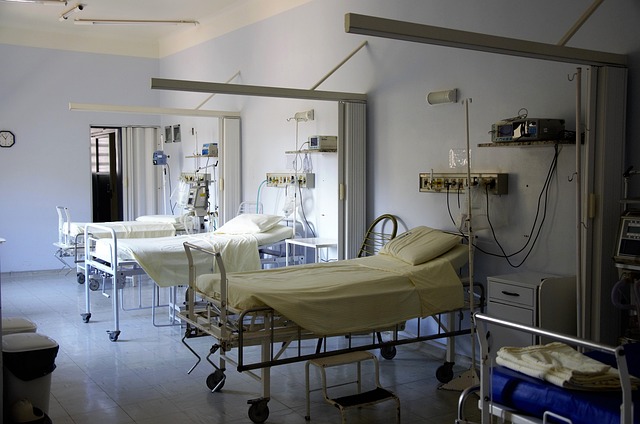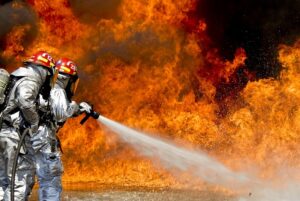
Fire Stopping Guide for Ireland’s Healthcare: Enhancing Hospital & Care Home Safety
In healthcare facilities, where the well-being and safety of patients are of paramount importance, the necessity of rigorous fire safety measures cannot be overstated. Hospitals and care homes, with their complex infrastructure and vulnerable populations, present unique challenges in fire safety management. These institutions not only house individuals with varying degrees of mobility and health conditions but also contain a myriad of medical equipment and substances that could exacerbate fire situations.
Thus, ensuring that effective fire stopping measures are in place is crucial to safeguarding both lives and property. This guide aims to provide comprehensive insights into the best practices, standards, and innovative solutions in fire stopping specific to Ireland’s healthcare sector, emphasising the significance of tailored fire safety strategies to enhance protection and resilience in these critical settings.
Fire stopping, a critical component of fire safety in buildings, entails the use of fire-resistant materials and technologies to prevent the spread of fire and smoke through gaps and openings in fire-resistant walls and floors. In the context of hospitals and care homes in Ireland, where the stakes are significantly higher, fire stopping takes on an unparalleled importance.
The primary goal is to compartmentalise areas to ensure that fire, if it breaks out, can be contained within a limited area, thereby giving occupants more time to evacuate and allowing emergency services to respond more effectively.
This is particularly crucial in healthcare settings where patients may have limited mobility or are entirely dependent on the assistance of healthcare staff for evacuation. Furthermore, it protects critical infrastructure and medical equipment, which are essential for patient care and may be highly sensitive to smoke and fire damage.
In Ireland’s rigorous regulatory environment, adherence to stringent fire stopping standards is not just a matter of compliance, but a moral imperative to ensure the highest level of safety for those who are most vulnerable.
Check out our Healthcare Case Studies.
Understanding Fire Stopping
Definition and Key Components of Fire Stopping Systems in Healthcare
At its core, fire stopping in healthcare environments involves designing and implementing barriers that are capable of resisting fire and smoke for a specified period. These systems include a combination of products and techniques intended to seal off penetrations and gaps in walls, floors, and ceilings that could otherwise allow the passage of fire and smoke between compartments.
The key components of fire stopping systems typically comprise intumescent materials, fire-resistant sealants, and compounds, as well as specialised devices such as firestops and fire dampers which are installed within ventilation systems.
In healthcare facilities, special attention is paid to the integrity of passive fire protection schemes, ensuring that critical areas such as operating theatres, intensive care units, and patient wards are prioritised for enhanced protection. Integral to this process is the use of materials and solutions that have been rigorously tested and certified to meet Ireland’s comprehensive fire safety standards, a testament to the commitment to safeguarding human life and critical infrastructure in these settings.
The Role of Fire Stopping in Compartmentalization
The principle of compartmentalization plays a pivotal role in fire safety strategy, particularly within the context of healthcare facilities in Ireland. By dividing a building into sealed fire-resisting compartments, fire stopping measures effectively slow the spread of fire and smoke, a critical factor in safeguarding lives and property. This approach hinges on the integrity of walls, floors, and ceilings, which are fortified with fire-resistant materials to create barriers that can withstand fire for a significant period, typically between 30 to 120 minutes depending on the specific requirements of the area.
Compartmentalization serves multiple purposes; it not only provides vital time for the evacuation of patients, staff, and visitors but also limits damage to critical areas and equipment. The containment of fire within a compartment drastically reduces the overall impact, allowing emergency services to focus their efforts on controlling and extinguishing the fire more efficiently. Furthermore, by preventing the widespread dissemination of smoke, which is often more deadly than the fire itself, compartmentalization significantly improves the chances of survival for occupants.
Fire stops and fire dampers, integral components of fire stopping systems, are installed within openings and ventilation systems to maintain the compartment’s integrity. These elements are designed to automatically activate in the event of a fire, sealing off the passage of flames and smoke, and are essential in maintaining the effectiveness of the compartmentalization strategy.
Regulatory Framework in Ireland
Overview of Irish Regulations and Standards for Fire Safety in Healthcare Facilities
In Ireland, the regulatory framework governing fire safety in healthcare facilities is both comprehensive and stringent, embodying the nation’s commitment to protecting vulnerable populations from the hazards of fire. Central to this framework is the Building Regulations 1997-2019, particularly Part B – Fire Safety, which sets out the legal requirements for fire safety provisions in all buildings, including hospitals and care homes.
Further specifying these requirements, the Technical Guidance Document B (Fire Safety) provides detailed guidance on achieving compliance, encompassing fire stopping measures to prevent the spread of fire and smoke within healthcare facilities. Healthcare facilities must also adhere to the Health Service Executive’s (HSE) National Standards for Safer Better Healthcare, which incorporate safety from fire as part of a broader approach to ensuring safe, quality care.
In addition to national regulations, Irish healthcare facilities often refer to internationally recognised standards such as those from the National Fire Protection Association (NFPA) and the British Standards Institution (BSI) to inform best practices in fire safety management and fire stopping solutions. For instance, the use of fire stopping products and systems is expected to meet the performance requirements set by standards such as EN (European Norm) standards, ensuring a high level of fire resistance and integrity.
Compliance with these regulations and standards is not merely a legal obligation but a moral one, ensuring that the health and safety of patients, staff, and visitors are safeguarded against the risk of fire. Regular audits, risk assessments, and fire safety reviews are mandated to maintain high standards of fire safety preparedness in Ireland’s healthcare facilities, demonstrating an unwavering dedication to fostering safe environments for both healing and care.
Assessing Fire Risks in Healthcare Settings
Common Fire Hazards in Hospitals and Care Homes
In the context of healthcare settings, identifying and managing fire risks is crucial to ensure the safety of patients, staff, and visitors. Hospitals and care homes are particularly vulnerable to fire hazards due to the presence of various risk factors. One common hazard is the use of electrical equipment, which ranges from medical devices to personal appliances brought in by patients and visitors. Faulty wiring, overloaded power sockets, and the use of non-compliant electrical devices can lead to electrical fires, posing a significant risk.
Another prevalent hazard is the storage and use of oxygen and other gases in clinical areas. These materials are highly combustible and can escalate a fire situation rapidly if not handled or stored correctly. Additionally, the accumulation of waste materials, such as paper, textiles, and plastics, provides readily available fuel for fires, especially when proper waste management protocols are not observed.
Kitchens and cooking areas within healthcare facilities also represent a notable fire risk, given the combination of cooking equipment, oils, and open flames. Lastly, compromised fire doors and escape routes, either through malfunctioning mechanisms or obstructions, can severely hinder evacuation efforts during a fire.
Identifying these hazards is the first step in mitigating the risk of fire in healthcare settings. Through thorough risk assessments and the implementation of stringent safety measures, the potential impact of these hazards can be significantly reduced.
Conducting thorough fire risk assessments in healthcare settings is a vital process that involves a systematic examination of all potential fire hazards that could endanger the lives of patients, staff, and visitors. It encompasses identifying hazards, evaluating the likelihood and potential impact of a fire, and determining appropriate control measures to minimise risk. This ongoing process not only identifies immediate corrective actions but also aids in the formulation of an effective fire safety management plan, ensuring compliance with the regulatory framework and standards outlined previously.
Fire Risk Assessments are critical.
Effective risk assessments are characterised by a detailed inspection of the facility, including patient care areas, storage rooms, technical spaces, and administrative areas, to identify risks associated with electrical equipment, medical gases, flammable materials, and emergency exit routes. It also involves a review of fire detection and suppression systems, emergency lighting, and communication systems to ensure they are in optimal condition and meet the required standards.
Key to this process is the involvement of all stakeholders, including fire safety officers, healthcare professionals, and maintenance staff, to gain a comprehensive view of fire safety practices and potential risks. Collaboration with local fire authorities for expert advice and guidance can further enhance the quality of the fire risk assessment.
Regular updates to the risk assessment are crucial, especially when there are significant changes within the facility, such as new construction, renovation, or the introduction of new medical equipment, to ensure that the fire safety measures remain effective and compliant with current standards and regulations.
Fire Stopping Solutions for Healthcare Facilities
In addressing the complexities of fire safety in healthcare settings, particularly hospitals and care homes, the selection and implementation of fire stopping solutions play a pivotal role. Fire stopping products are designed to seal openings and joints in fire-resistance-rated walls and floors, preventing the spread of fire, smoke, and toxic gases. These solutions are vital in maintaining the integrity of fire compartmentalisation within healthcare facilities.
Types of Fire Stopping Products and Their Applications
- Intumescent Sealants and Paints: These materials expand significantly when exposed to high temperatures, sealing gaps and maintaining the integrity of fire barriers. They are commonly used around the edges of fire doors, windows, and in joints between fire-resistant walls and floors.
- Fire Dampers: Installed in ducts passing through fire-resistant barriers, fire dampers automatically close in the event of a fire, blocking the spread of flames and smoke. They are essential in healthcare facilities for maintaining ventilation and air quality while ensuring fire safety.
- Firestop Collars: These are placed around pipes and cables that penetrate fire-rated walls and floors. On exposure to heat, firestop collars expand, sealing off the penetration to prevent the passage of fire and smoke. They are crucial in areas where services and utilities traverse fire compartments.
- Fire Pillows and Mortar: Designed for use in larger openings or complex penetrations, fire pillows can be packed around cables and pipes, offering flexibility and easy removal or addition when services change. Fire mortar provides a more permanent solution, filling large openings with a fire-resistant compound that sets solid.
- Composite Sheets: Often used to seal larger openings or as temporary fire barriers during construction, composite sheets can be cut to size and installed to provide immediate fire resistance. Their use is particularly relevant in renovation projects within healthcare settings, where temporary protection is required.
The effective application of these fire stopping products in hospitals and care homes demands a thorough understanding of the specific fire safety challenges inherent to each facility. It also requires collaboration with specialists in fire safety to ensure that all measures not only comply with national and international standards but also address the unique needs of healthcare environments where the safety and well-being of vulnerable occupants are paramount.
Regular inspection, maintenance, and, where necessary, replacement of fire stopping solutions are crucial to guarantee their performance in the event of a fire. This proactive approach forms an integral part of a comprehensive fire safety strategy in healthcare facilities, ensuring a high level of protection for patients, staff, and visitors alike.
Maintenance and Inspection of Fire Stopping Systems
The enduring effectiveness of fire stopping systems in healthcare facilities hinges on regular and meticulous maintenance routines, accompanied by comprehensive inspections.
Routine maintenance practices for these installations involve periodic checks to ensure that all fire stopping solutions, including sealants, fire dampers, and collars, remain in optimal condition, unaffected by daily operations or environmental factors. Maintenance teams must pay particular attention to any signs of degradation or damage that could compromise the system’s integrity, executing prompt repairs or replacements as warranted.
Regular inspections and audits are equally critical, serving as a dual check on the system’s compliance with prevailing fire safety standards and its operational effectiveness. These inspections should be methodically planned and conducted by qualified fire safety professionals who evaluate the condition and performance of fire stopping components against rigorous criteria. Any deviations from standards or performance benchmarks necessitate immediate corrective measures. Additionally, audits provide an opportunity to review and update fire safety protocols, ensuring they align with the latest fire safety legislation, technological advancements, and the evolving needs of the healthcare environment.
Training and Awareness for Health Care Staff
The significance of training and raising awareness among healthcare staff about fire safety protocols and fire stopping systems cannot be overstressed. It is imperative that all staff, from medical professionals to administrative and support personnel, are well-versed in the fire safety measures implemented within their facility. This includes understanding the function and importance of fire stopping solutions, recognising the roles they play in preventing the spread of fire and smoke, and knowing how to act swiftly and efficiently in the event of a fire.
Developing emergency response plans specifically tailored to healthcare settings involves preparing staff to handle a variety of scenarios that could arise in such complex environments. Training should encompass evacuation procedures, the use of fire safety equipment, and the execution of role-specific responsibilities during an emergency. Additionally, healthcare facilities must ensure these plans accommodate the needs of patients, including those who are immobile or require specialised medical equipment, making staff training on these protocols even more crucial.
By fostering a culture of fire safety awareness and preparedness through regular training sessions and drills, healthcare institutions can significantly mitigate the risks associated with fire incidents. Such proactive measures not only protect the physical infrastructure but, more importantly, safeguard the lives of patients, staff, and visitors, ensuring a safe and secure environment for all.
Future Trends in Fire Safety for Healthcare Facilities
The landscape of fire safety within healthcare environments is poised for transformation, driven by innovations and advancements in fire stopping technologies. One of the most significant trends is the integration of smart technologies, which promises to enhance the effectiveness of fire safety measures in hospitals and care homes significantly.
Smart Fire Stopping Solutions: The advent of intelligent fire stopping systems, embedded with sensors and connected via the Internet of Things (IoT), enables real-time monitoring of the integrity and performance of fire protection barriers. These smart systems can directly alert maintenance teams to any degradation or breach, facilitating immediate remediation and ensuring continuous protection.
Automated Maintenance and Inspections: Future fire safety protocols in healthcare facilities will likely incorporate automated technologies for routine inspections and maintenance checks. Using drones or robotics equipped with advanced sensors to inspect hard-to-reach areas for any signs of compromise could streamline these processes, reducing human error and ensuring a thorough evaluation of fire stopping systems.
Integration with Building Management Systems: The integration of fire stopping technologies with broader building management systems (BMS) represents another forward-looking trend. This integration enables a cohesive approach to fire safety, where fire stopping measures work in concert with other safety and security systems, including automatic door closures, smoke extraction systems, and emergency lighting, enhancing the overall safety of the healthcare environment.
Predictive Analytics for Fire Safety: Leveraging the power of big data and predictive analytics, future fire safety strategies in healthcare will likely predict potential issues before they arise. By analysing historical data, these systems can identify trends and anticipate failures, allowing pre-emptive action to address vulnerabilities, thereby preventing fires before they can start.
These advancements underscore a paradigm shift towards more proactive and intelligent fire safety strategies in healthcare settings. By harnessing smart technologies, healthcare facilities can not only comply with rigorous fire safety standards but also offer unrivalled protection for their patients, staff, and visitors, setting a new benchmark for fire safety in healthcare environments.
Conclusion
In conclusion, the critical role of fire stopping in healthcare facilities cannot be understated. These systems are fundamental in preventing the spread of fire and smoke, thereby ensuring the safety and well-being of patients, staff, and visitors alike. With healthcare settings being inherently complex environments, it is paramount that fire stopping solutions are meticulously maintained and regularly inspected to meet the highest standards of fire safety.
The encouragement of proactive measures—through the integration of smart technologies and adherence to rigorous fire safety protocols—highlights a commitment to not just compliance with regulations, but to the pursuit of excellence in safeguarding lives.
Healthcare facilities must continue to prioritise fire safety as a core aspect of their operations, fostering an environment that is not only secure but also conducive to the health and recovery of patients. The evolution of fire safety through technological advancements presents an opportune moment for healthcare administrators to reassess and enhance their fire safety measures, ultimately contributing to a safer and more resilient healthcare system.
With the evolving landscape of fire safety in healthcare facilities and the critical importance of protecting lives and infrastructure, now is the opportune moment for healthcare administrators to review and enhance their fire safety protocols.
Flame Stop is dedicated to providing cutting-edge fire stopping solutions tailored to the unique needs of healthcare environments. We urge you to reach out to our team of fire safety experts for a comprehensive assessment of your facility’s current fire safety measures and to explore advanced solutions designed to offer superior protection.
Don’t wait until it’s too late—contact Flame Stop today to ensure your facility is equipped with the latest in fire safety technology, safeguarding your patients, staff, and assets for years to come.
Royalty free Images supplied from PixaBay as part of SEO service from 3R.



